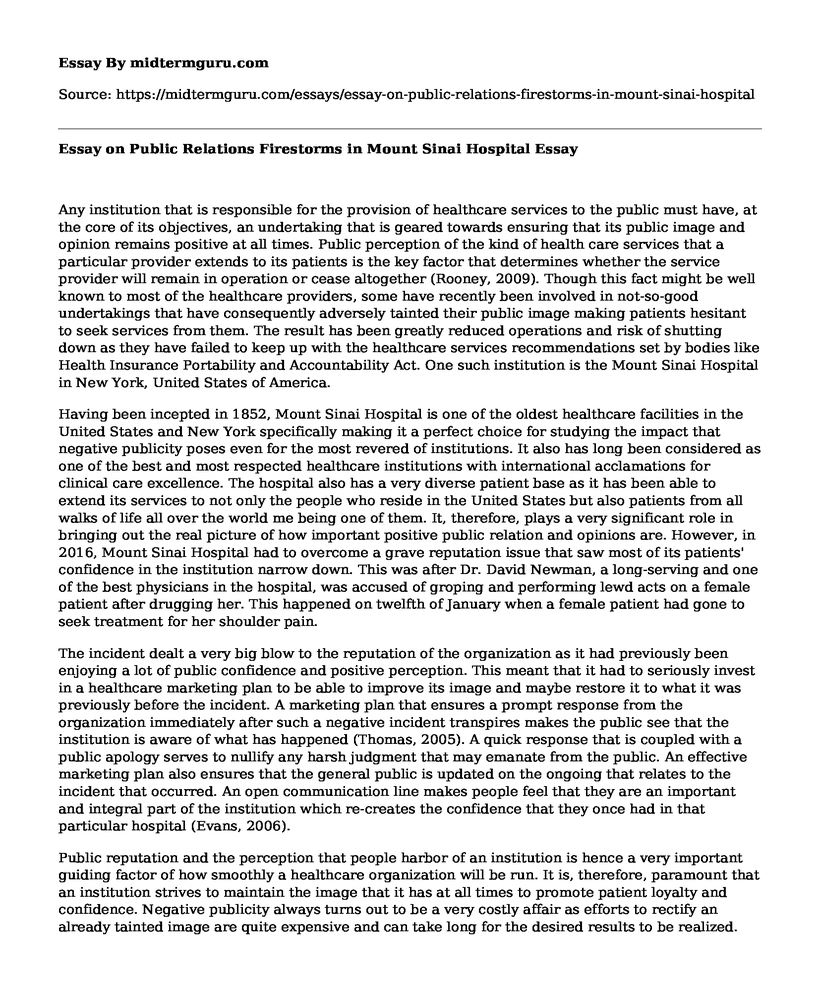Any institution that is responsible for the provision of healthcare services to the public must have, at the core of its objectives, an undertaking that is geared towards ensuring that its public image and opinion remains positive at all times. Public perception of the kind of health care services that a particular provider extends to its patients is the key factor that determines whether the service provider will remain in operation or cease altogether (Rooney, 2009). Though this fact might be well known to most of the healthcare providers, some have recently been involved in not-so-good undertakings that have consequently adversely tainted their public image making patients hesitant to seek services from them. The result has been greatly reduced operations and risk of shutting down as they have failed to keep up with the healthcare services recommendations set by bodies like Health Insurance Portability and Accountability Act. One such institution is the Mount Sinai Hospital in New York, United States of America.
Having been incepted in 1852, Mount Sinai Hospital is one of the oldest healthcare facilities in the United States and New York specifically making it a perfect choice for studying the impact that negative publicity poses even for the most revered of institutions. It also has long been considered as one of the best and most respected healthcare institutions with international acclamations for clinical care excellence. The hospital also has a very diverse patient base as it has been able to extend its services to not only the people who reside in the United States but also patients from all walks of life all over the world me being one of them. It, therefore, plays a very significant role in bringing out the real picture of how important positive public relation and opinions are. However, in 2016, Mount Sinai Hospital had to overcome a grave reputation issue that saw most of its patients' confidence in the institution narrow down. This was after Dr. David Newman, a long-serving and one of the best physicians in the hospital, was accused of groping and performing lewd acts on a female patient after drugging her. This happened on twelfth of January when a female patient had gone to seek treatment for her shoulder pain.
The incident dealt a very big blow to the reputation of the organization as it had previously been enjoying a lot of public confidence and positive perception. This meant that it had to seriously invest in a healthcare marketing plan to be able to improve its image and maybe restore it to what it was previously before the incident. A marketing plan that ensures a prompt response from the organization immediately after such a negative incident transpires makes the public see that the institution is aware of what has happened (Thomas, 2005). A quick response that is coupled with a public apology serves to nullify any harsh judgment that may emanate from the public. An effective marketing plan also ensures that the general public is updated on the ongoing that relates to the incident that occurred. An open communication line makes people feel that they are an important and integral part of the institution which re-creates the confidence that they once had in that particular hospital (Evans, 2006).
Public reputation and the perception that people harbor of an institution is hence a very important guiding factor of how smoothly a healthcare organization will be run. It is, therefore, paramount that an institution strives to maintain the image that it has at all times to promote patient loyalty and confidence. Negative publicity always turns out to be a very costly affair as efforts to rectify an already tainted image are quite expensive and can take long for the desired results to be realized. Proper and highly effective healthcare marketing plans thus ought to be employed in the case of such happenings as the image of any institution, be it healthcare or otherwise, remains to be its most important asset (Kay, 2007).
References
Evans, W. D. (2006). How social marketing works in health care. Bmj, 332(7551), 1207-1210.
Kay, M. J. (2007). Healthcare marketing: what is salient?. International Journal of Pharmaceutical and Healthcare Marketing, 1(3), 247-263.
Rooney, K. (2009). Consumer-driven healthcare marketing: using the web to get up close and personal. Journal of Healthcare Management, 54(4), 241-251.
Thomas, R. K. (2005). Marketing health services. Health Administration Press.
Cite this page
Essay on Public Relations Firestorms in Mount Sinai Hospital. (2021, May 28). Retrieved from https://midtermguru.com/essays/essay-on-public-relations-firestorms-in-mount-sinai-hospital
If you are the original author of this essay and no longer wish to have it published on the midtermguru.com website, please click below to request its removal:
- General Discussion of Consumer Behaviour - Paper Example
- Market Research for the Laptop - Paper Example
- Essay Example on Process of Bringing a Product or Service to Market
- The Theory of Competitive Markets - Paper Example
- Paper Example on Supply Chain Management
- Paper Example on Supply Chain and Logistic Technology
- Price Skimming: A Pricing Strategy for Max Profit - Essay Sample







